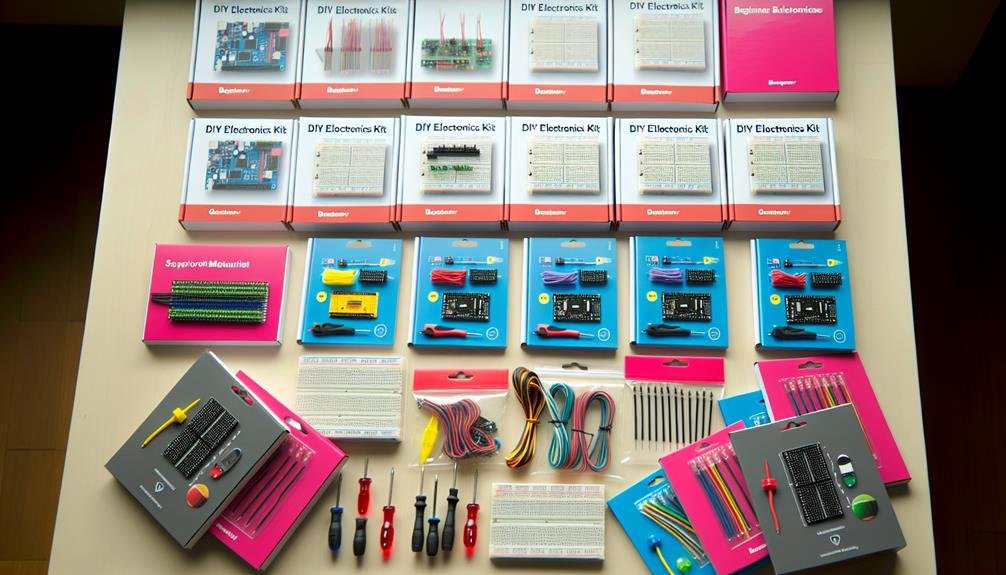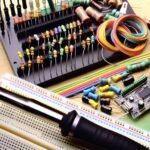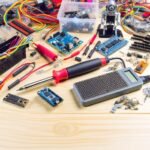You may think that choosing the best DIY electronics kit for beginners is a daunting task, especially if you have no prior experience in this field. However, with a little guidance, you can confidently embark on this exciting journey.
So, where do you start? Well, in this discussion, we will explore some key factors that can help you make an informed decision. From assessing your skill level to considering future project possibilities, we will provide you with the essential steps to choose the perfect DIY electronics kit for your needs.
So, let's dive right in and discover how you can kickstart your electronics journey.
Key Takeaways
- Assess your skill level and familiarity with circuits before choosing a DIY electronics kit.
- Consider the complexity of the kit by evaluating the number of components, technical knowledge required, cost, and quality of instructions.
- Research the compatibility, quality, and reputation of the included components through reviews and specifications.
- Look for kit support and resources such as online communities, troubleshooting guides, tutorials, and reliable customer support.
Understanding Your Skill Level
Before diving into the world of DIY electronics, it's important to assess your skill level and understanding of electronic components and circuits. This will help you choose the right DIY electronics kit that aligns with your abilities and goals. Skill progression is a crucial aspect to consider when starting your journey in DIY electronics.
As a beginner, you want to start with a kit that provides a gentle learning curve. Look for kits that offer step-by-step instructions and include basic components like resistors, capacitors, and LEDs.
Understanding your skill level also involves evaluating your familiarity with circuits. If you have no prior knowledge, it's recommended to begin with a kit that focuses on teaching circuit fundamentals. These kits often provide clear explanations and hands-on activities to help you grasp the concepts effectively.
As you gain more confidence and experience, you can progress to more advanced kits that introduce complex circuits and components. This gradual approach allows you to build a solid foundation and gradually expand your knowledge and skills.
Evaluating Kit Complexity
To assess the complexity of a DIY electronics kit, carefully evaluate the number of components and the level of technical knowledge required. Here are four key factors to consider when evaluating kit complexity:
- Number of Components: Take into account the number and variety of components included in the kit. More components generally indicate a higher complexity level, as you'll need to understand how they interact and connect to create the desired circuit.
- Technical Knowledge Required: Consider the level of technical knowledge required to successfully complete the project. Some kits are designed for beginners with minimal technical expertise, while others may assume a certain level of familiarity with electronics concepts.
- Evaluating Kit Cost: While not directly related to complexity, evaluating the cost of the kit can provide some insight into its complexity. Higher-priced kits often include more advanced components or additional features, which may require a higher level of technical knowledge to assemble and operate.
- Comparing Kit Instructions: Carefully review the instructions provided with the kit. Clear and detailed instructions can greatly simplify the assembly process, even for more complex kits. Look for kits that provide step-by-step guidance, diagrams, and explanations to help you understand the circuitry and troubleshoot any issues that may arise.
Assessing Included Components
When assessing the complexity of a DIY electronics kit, one important aspect to consider is the evaluation of the components included in the kit. Component compatibility is a key factor to ensure that the included components can be easily interconnected and work together seamlessly. Before making a purchase, it's crucial to examine whether the included components are compatible with each other and with the user's intended project.
Another crucial consideration is the quality of the included components. High-quality components are essential for a successful DIY electronics project. Poor quality components may lead to unreliable performance, frequent failures, and even potential safety hazards. It's advisable to opt for kits that include components from reputable manufacturers known for their reliability and durability.
To assess the quality of included components, it's recommended to read reviews and feedback from other users who've purchased and used the kit. This can provide valuable insights into the performance and reliability of the components. Additionally, checking the specifications of the components, such as their voltage and current ratings, can help determine their suitability for the intended project.
Researching Kit Support and Resources
One crucial aspect to consider when choosing a DIY electronics kit for beginners is researching the available kit support and resources. This ensures that you have the necessary assistance and materials to successfully complete your projects.
Here are four key steps to take when researching kit support and resources:
- Identifying online communities: Look for forums, online groups, or social media platforms dedicated to DIY electronics. These communities are invaluable sources of knowledge and support. You can ask questions, share your progress, and learn from experienced enthusiasts.
- Exploring troubleshooting guides: Check if the kit manufacturer provides comprehensive troubleshooting guides. These guides can help you diagnose and solve common issues that may arise during your projects. Having access to detailed troubleshooting resources can save you time and frustration.
- Reviewing online tutorials and documentation: Look for kits that come with detailed tutorials or documentation. These resources provide step-by-step instructions, explanations of circuitry concepts, and project ideas. They're essential for beginners who want to understand the principles behind their projects.
- Checking for customer support: Ensure that the kit manufacturer offers reliable customer support. This can be in the form of email, live chat, or phone support. Knowing that you can reach out to an expert when you encounter difficulties can give you peace of mind.
Considering Future Project Possibilities
Having thoroughly researched the available kit support and resources, you're now ready to explore the exciting possibilities for future projects. As a beginner, it's important to start with the basics and gain a solid foundation in electronics. However, once you have mastered the fundamentals, you can start exploring advanced projects that push the boundaries of your knowledge and skills.
One way to expand your horizons is by exploring advanced projects that delve into more complex concepts and technologies. This could involve building circuits with integrated circuits (ICs), working with microcontrollers, or even experimenting with wireless communication protocols like Bluetooth or Wi-Fi. These advanced projects will challenge you to apply your knowledge in new and creative ways, allowing you to further develop your skills.
Additionally, you may also want to consider exploring niche projects that align with your specific interests and passions. For example, if you're interested in robotics, you could explore projects that involve building and programming robots. If you have a fascination for renewable energy, you could explore projects that focus on solar panels or wind turbines. By choosing projects that align with your interests, you won't only have more fun but also gain a deeper understanding of the subject matter.






